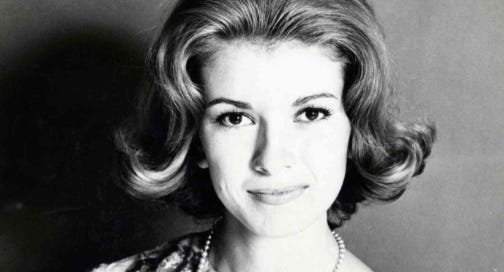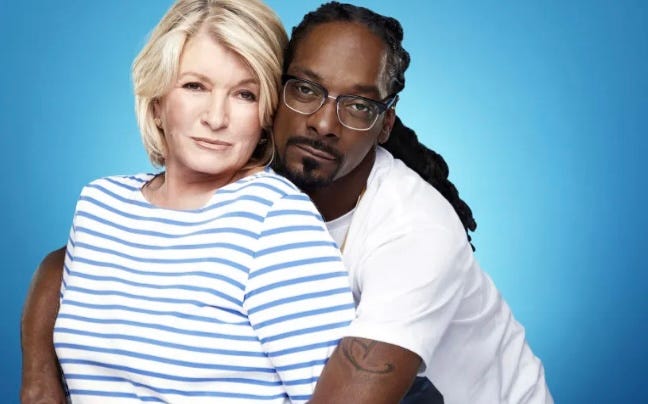Martha Stewart Cooperates With A Documentary, Then Finds It Imperfect
Even though it's authorized, she's not happy
Hello! Welcome to new readers of the CulinaryWoman Newsletter, and greetings to everyone who’s returned. CulinaryWoman looks at topics in the food world with a slant toward business stories, adding my personal perspective. And this week, I’m looking at one of the most successful female entrepreneurs of our time.
The Two Sides of Martha Stewart
About two-thirds of the way through a new Netflix documentary on her life, Martha Stewart is asked what her net worth would be if she had not gone to prison. “Billions,” she replies in a flat tone. Not, “Billions, but it was a new start for me.” Just, “Billions.”
It’s clear that Martha takes names and hold grudges, including one that she surprisingly feels about this film, produced by the famed documentarian R.J. Cutler. When Martha reached Netflix on Oct. 30, its subject criticized the choices that Cutler made and said she would have told her story differently.
Perhaps that’s because Cutler included the entire Martha story, not the polished, filtered version that she presented of her life.
Lately, as the documentary has proven very popular on the streaming service, Martha has softened her objections, saying that she’s glad it exists because her grandchildren can understand her success.
I read a take on social media that suggested this approach was deliberate to keep the documentary in the news: do the initial marketing rollout, object to the film, keeping it in the conversation, and then make peace with what is now a successful streamer.
Throughout Martha, you see a similar pattern: she’s prickly when she doesn’t have control, charming when things are working out.
For people who don’t know the Martha story, she was born in Nutley, N.J., a member of a large family. Her father, it turns out, was verbally and physically abusive to the children; her mother, Big Martha, kept the family together.
Martha got out as soon as she could. She became a teen model, met Andy Stewart when she was just 19 (her father objected because he was Jewish, a detail I don’t think was widely known), and was a young bride.
Her marriage faltered from the start, prompting Martha to look for an escape hatch. She became a stockbroker, a rarity for women in the 1960s, and was on Wall Street between 1968 and 1973.
Burning out on finance, she started a catering business in Westport, Connecticuts, in 1976. This chapter of Martha’s life was revealing, and during this portion of the film, we begin hearing the word that resounds through the film: “perfect.” She wanted everything she did for her clients to be precise.
There was no shabby chic about what Martha did, nothing accidental about her strategy. She invented her own recipes, and made it all from scratch.
Fortunately for Martha, one of her catering clients was a major New York publisher, for whom she did a book launch party. Impressed with her work, he suggested that she write a book on entertaining.
Building an empire, then seeing it collapse
Martha’s first book deal was for Entertaining, which sold 660,000 copies and launched her business empire.
Through the years, Martha has put her name of 8,000 products, from clothing and garden implements, to meal kits, cake stands, bedding and bakeware.
There have been multiple TV shows, a magazine, and podcast. She has been ubiquitous on talk shows, both daytime and late night. She is about to publish her 100th book, coincidentally highlighting the previous 99 on her social media.
In the film, she explains that she was a natural teacher, and her goal was to help any woman, at any income level, do their best.
Martha talks about her association with Kmart, which was key to broadening her influence. At the time she joined forces with them, Kmart was considered somewhat low rent, and Martha burnished its image.
I was never a Kmart shopper, except in one area: Martha Stewart products. When I needed new garden containers, or sheets, I prowled my nearest Kmart to see what the Martha line had to offer.
But Martha did not want to base her brand primarily on another brand. She wanted to be a brand. She’s been called the OG influencer, but that understates her standing in the business world.
In 1999, Martha Stewart Omnimedia went public, making her an instant billionaire. Only two years later, she made a misstep that led to her stint in prison. She sold stock in ImClone, based on a tip received by her stockbroker, before key information was made public.
Given that she had a clean record and insider trading was a white collar crime, it was widely assumed Martha would pay a fine, but avoid jail time. Instead, she ended up in Alderson federal prison in West Virginia for 150 days. With her in the slammer, the business empire crumbled.
At the time, Martha served her time with seeming good humor, strutting out of prison and onto a private plane clad in a poncho knitted by a fellow inmate. When she shed her ankle bracelet and returned to her television show, audience members wore similar ponchos as a jolly inside joke.
However, in the documentary, Martha seethes over having gone to prison. The prosecutor who put her away was James Comey, later director of the FBI, and you can envision Martha giving him a swift kick if she ever encounters him. The prison time, to hear her tell it, was dreadful, despite being a turning point in the way people viewed her.
Contrasting images
That simmering anger is a contrast to the modern image she has crafted for herself as a still-relevant figure, hip enough to hang with Snoop Dogg, appealing enough to be featured during NBC’s Olympics coverage, and savvy enough to star on Instagram and YouTube.
It helps you understand why earlier this fall, stories emerged of a feud Martha and Ina Garten. In a New Yorker profile, Martha contended that Ina stopped speaking to her when she went to prison. Ina’s version was that they lost touch when Martha moved from Westport, Connecticut to Bedford, N.Y.
Or maybe, Ina just did not like her. That’s easy to believe after watching Martha on Netflix. The documentary makes her seem a little less frothy and much more steely. Cutler says he understands her objections.
"Guess what? Martha saw the film and she told me what she thought about it," Cutler told Matthew Belloni on the latest episode of The Town podcast. "It wasn't surprising to me that she would've made a different film that I made. She gave me her feedback, and she was upset that I didn't make the changes she wanted to make. But this is the process.”
I found Martha well worth a watch. If you remember her glory days, you’ll revel in 1980s and 1990s nostalgia. If you don’t know Martha’s story, this is a version that tell it with perspective, not just what she’d have you believe.
Chef To Diners: Order More Food
The Yellow Bittern is a tiny British restaurant, open just for lunch, that has only been open a few weeks. But its owner, Hugh Corcoran, has already caused a social media stir. He thinks customers should order more food.
Restaurants are not public benches,” he wrote on Instagram two weeks ago. “You are there to spend money.”
He complained, “It is now apparently completely normal to book a table for four people, say, and then order one starter and two mains to share and a glass of tap water.”
Corcoran maintains “there was at one point an etiquette in restaurants that if you booked a table in a nice place you at the very least had to order a main course (and possibly even a starter or dessert) and drink wine in order for your table to be worth serving.”
I’m not so sure about that. But he is not alone in his gripes.
The Times of London talked to restaurant owners who griped about people asking for free food, customers walking out without paying, and patrons who drown food in ketchup or mayonnaise.
It seems that if customers are going to complain, some owners are, too.
An Inquisitive Rice Cooker
I am a fan of Zojirushi, the Japanese appliance brand. I’ve owned their hot water dispensers for years and I know many people swear by their rice cookers.
So, I was fascinated to read about its new model, the NW-JEC10/18, which clocks in at $750 retail. That’s hundreds more than many people would pay for a rice cooker. (I actually don’t use one; I make rice in the oven.)
However, Epicurious says this one is special. It has a setting to tailor rice to your personal needs. “The My Rice setting, which is designed to work with short-grain white rice, adjusts the cook settings to match your desired textural preferences for a bowl of rice,” Epicurious wrote.
When you select the setting, the machine starts by asking you for feedback about the previous bowl of rice. First you’re asked to assess the firmness of the batch, whether it was “not enough (too soft),” “ok,” or “too much (too firm).” It gives you the same question about the last batch’s stickiness.
The rice cooker takes that information into account, and makes the necessary adjustments to change the firmness and stickiness in the directions you want, then it begins cooking.
In case you think you can get too precise, there are only 49 possible variations on cooking method for the My Rice setting, the article says.
Épi says this cooker is “really for someone who has been on a dogged life-long journey on the search for a bowl of rice that is exactly to their own personal preferences, or it’s for someone who likes rice so firm or delicate and soft it’s hard to reproduce with lesser programmable rice cookers.”
I’m not that fussy. But I can think of several people who might fit that description.
Learning To Cook For Grocery Shoppers
In the Detroit area, Schoolcraft College is one of the leading places to train for a culinary career. A number of local chefs have taught classes and given demonstrations there.
While we think of culinary schools as providing chefs to restaurants, many graduates join grocery and specialty stores that sell food prepared in-house, whether grab and go or cooked to order. Now, they can get on the job training as part of their studies.
Nino Salvaggio International Marketplace is opening a 48,100 square-foot store adjacent to Schoolcraft in Livonia, Mich. The store is expected to open in fall 2025. It will have gourmet produce, meats, flowers, and more.
Nino Salvaggio is a well-known name in the Detroit area for top quality produce. Our area is lucky to have so many good sources of fruits and vegetables.
The store will give students a close up look at seasonal products - and presumably, feedback on their dinner specials.
"Having a Nino Salvaggio International Marketplace right here on campus will give all of our students real-world experience that will enhance their education," said Glenn Cerny, the president of Schoolcraft College.
Keeping Up With CulinaryWoman
The latest episode of the Great British Bake Off is 70s Week, while the Great Canadian Baking Show features Celebration Week.
As usual, I’ll review them in Red Beans & Rice tomorrow for paid subscribers. We’re closing in on the final episodes and GBBO has a runaway leader. The Canadian competition seems much closer.
I’d love to hear from you. Find and follow me here.
Website: www.michelinemaynard.com
Email: culinarywoman (@) gmail dot com
LinkedIn: Micheline Maynard
Threads and Instagram: (@) michelinemaynard
TikTok: CulinaryWoman
Have a good week!









